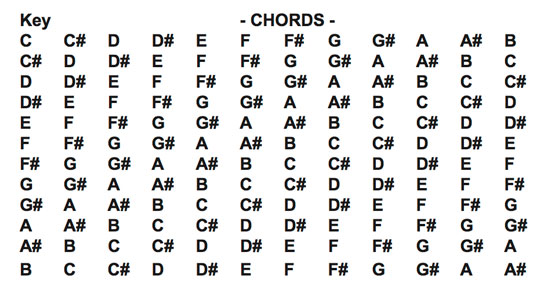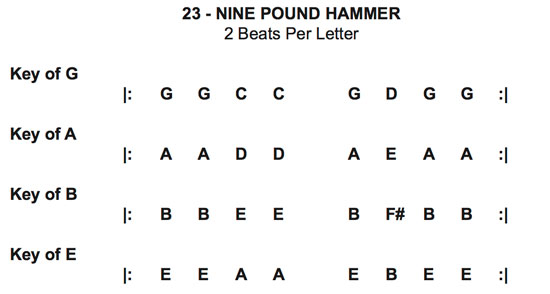|
HOME | LIST OF JAM SESSION CHORD PROGRESSIONS | FREE GUITAR CHORD CHARTS FREE MANDOLIN CHORD CHARTS | FREE BANJO CHORD CHARTS |
||
FREE BANJO LESSONS Bradley Laird's Free Bluegrass Banjo Lesson site is here! FREE CLAWHAMMER BANJO LESSONS Bradley Laird's Free Clawhammer Lesson site is located here! FREE MANDOLIN LESSONS Bradley Laird's Free Mandolin Lesson site is located here! FREE GUITAR LESSONS Bradley Laird's Free Bluegrass Guitar Lesson site is here!
©2015 Bradley Laird |
FREE
CHORD PROGRESSIONS - by Bradley Laird
How to Transpose Songs to a New Key The process of converting chords to a song to a new key is pretty simple. Without a lot of technical music theory let's look at this table. At first it may look complicated, but in 5 minutes it will be simple as pie!
The left-most column is a list of keys. There are 12 keys in which a song can be played and all 12 are listed there. You will notice that if you start at C and go horizontally you see the same list of chord names. Those are the notes of the chromatic scale which is just a fancy way of saying "all of the notes". You will notice that some chords are just a simple letter, like "D." Those note are called "naturals". In between some of the natural notes you will see chords marked with a "#" sign. That is not a Twitter hashtag. That symbol, in music, means "sharp" or one fret higher than the note below it. In other words, if you are on a C note and you go up one fret you will be on C#. If you go from C# up one fret you end up on D natural. There are a couple of notes (B and E) that do not have intervening "sharps". The next thing you need to know is that all of the "sharps" can also be called "flats" IF they are named for the note above them. Thus, C# can also be called D-flat or Db. We use the "b" to represent "flat" and a "flat" is one fret lower than the note above it. So, now that you have a basic understanding of natural notes, sharps and flats, let's look at the exact method for using this table to convert a complete song from one key (set of chords) to another. To use the chart above look down the left-most column for the key you are starting with. Let's say you are in the key of G and you are playing the chords G, C, and D. If you want to move that to the key of A you simply find the key of A on the left-most column and play the chords which line up with G, C, and D. If you look at the table you see that they are A, D and E. Now you might ask "What if the chord is a minor?" No big deal. Treat majors and minors the same. If your original chord progression was G, Am, D, G just ignore the minor indication and convert them to A, Bm, E, A. In other words, minors and majors convert in the same way. If a chord was major in the original, keep it major after converting. If it was minor in the original, tack on the minor after conversion. Look at this example of the song Nine Pound Hammer in 4 keys.
Compare those chords with the table above and you'll see how easy it is to convert (transpose) from one key to another. Here is a quick test to make sure you understand... If your song is in the key of A and the chords are A, Bm, E what would be the three chords if you transpose it to the key of D? (Answer at the very bottom of this page. Don't cheat. Use the table.) Download the PDF File: All 100 of the chord progressions from this site are available as a PDF file for printing on 8.5" x 11" pages. The download file includes 90 additional jam session favorites not shown on the website. Get information by clicking here. Additional Learning Resources: Brad Lairds Video Lesson: Chord Progressions By The Numbers Brad Lairds Book & CD: Mandolin Master Class Back to Index of Chord Progressions
Follow Me Answer: D, Em, A
| |



